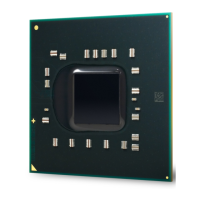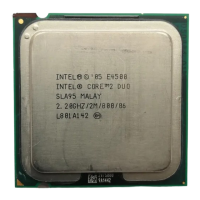Intel Thermal/Mechanical Reference Design Information
Thermal and Mechanical Design Guidelines 51
Table 8. Reliability Test Results
Use
Condition
Test Conditions Failure
mechanism
Results
T
LIQUID
= 75 ºC
for 16 weeks
1 0/10 failure
T
LIQUID
= 50 ºC 2 0.25-0.30 grams/week
T
LIQUID
= 50 ºC 3 Insignificant change in Ψca for 3
samples
Continuous
Operation
T
LIQUID
= 50 ºC 4 2% average RPM degradation after 8
weeks for 3 samples
T
LIQUID
= 35-60 ºC,
5500 cycles
1 0/3 failure
T
LIQUID
= 35-60 ºC,
5500 cycles
2 3 grams loss after all cycles for 3
samples
On-off
Cycles
T
LIQUID
= 35-60 ºC,
7500 cycles
4 No RPM degradation for 0/3 samples
5.2.4 Recommended BIOS/CPU/Memory Test Procedures
This test is to ensure proper operation of the product before and after environmental
stresses, with the thermal mechanical enabling components assembled. The test shall
be conducted on a fully operational motherboard that has not been exposed to any
battery of tests prior to the test being considered.
Testing setup should include the following components, properly assembled and/or
connected:
•
Appropriate system motherboard
• Processor
•
All enabling components, including socket and thermal solution parts
• Power supply
•
Disk drive
• Video card
•
DIMM
• Keyboard
• Monitor
The pass criterion is that the system under test shall successfully complete the
checking of BIOS, basic processor functions and memory, without any errors.

